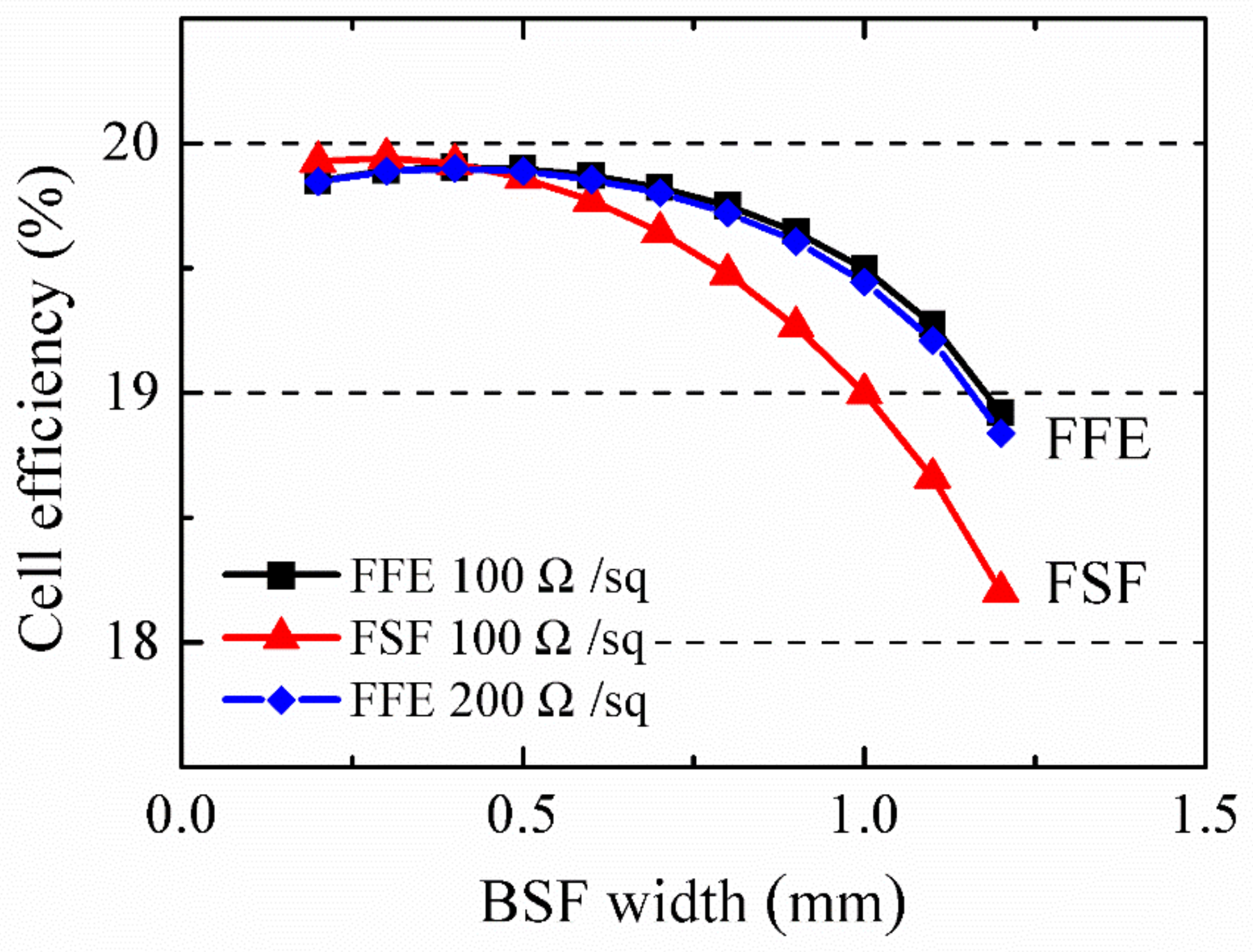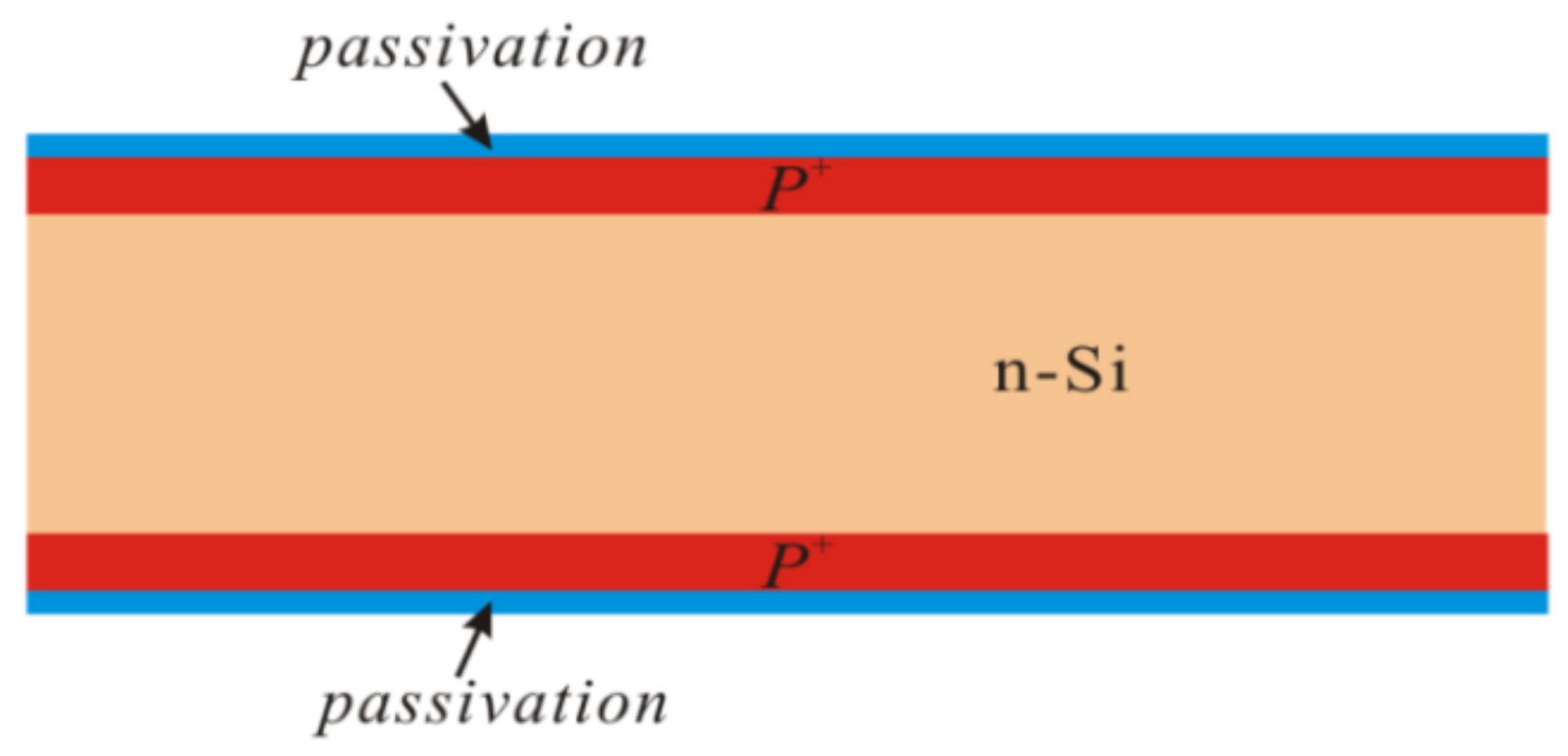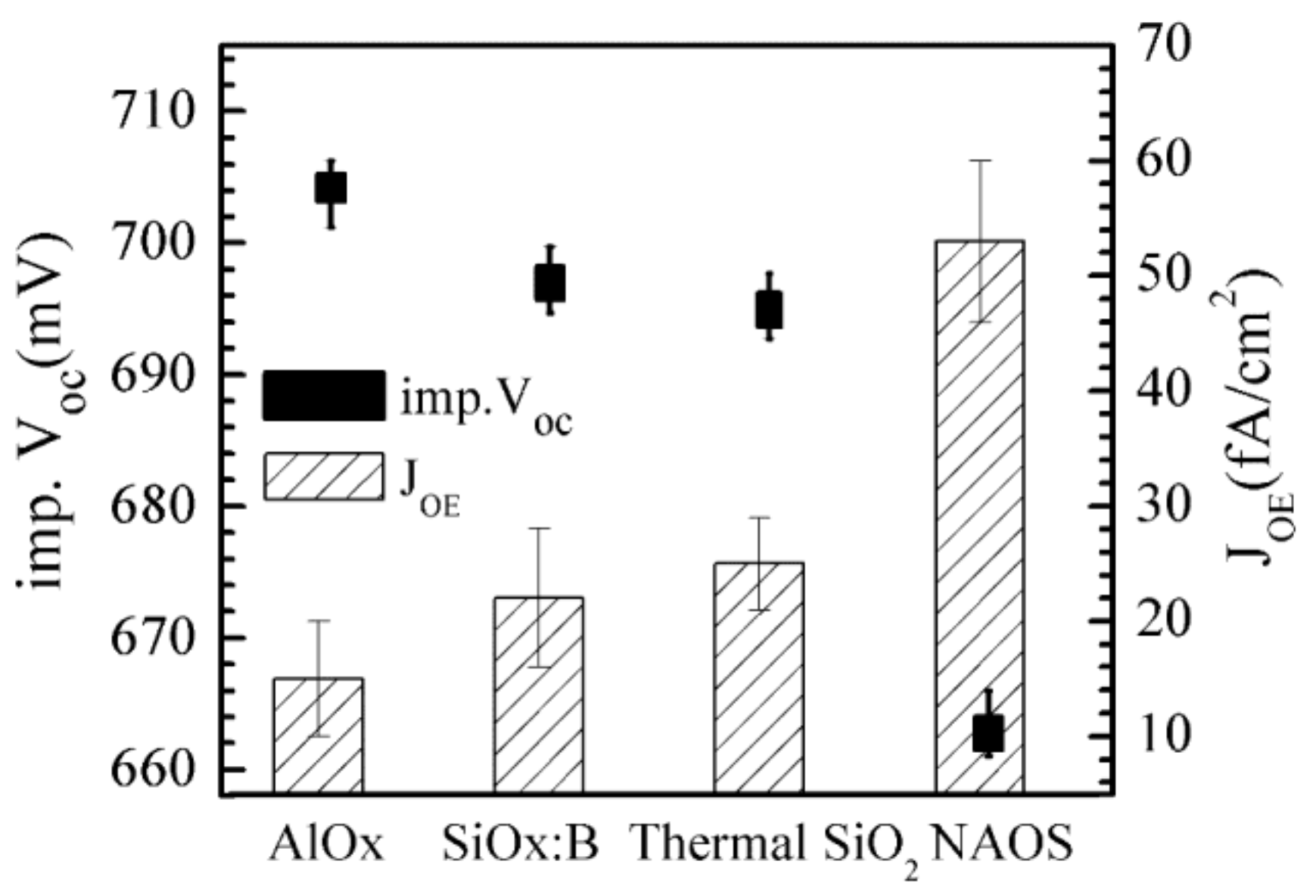Efficient Low-Cost IBC Solar Cells with a Front Floating Emitter: Structure Optimization and Passivation Layer Study
Abstract
:1. Introduction
2. Simulation Results and Discussion
2.1. Carrier Transport Properties
2.2. Effects of BSF Width on Solar Cell Efficiency
2.3. Influence of Different Resistivity and Emitter Width on FFE IBC Solar Cells
3. Experimental Results and Analysis
3.1. Influence of Thickness of SiOx:B Layer on Optical Properties
3.2. Effect of SiOx:B Layer Thickness on Passivation Quality
3.3. Comparison of Passivation Effect of Different Passivation Layers
4. Conclusions
Author Contributions
Conflicts of Interest
References
- Yang, G.; Ingenito, A.; Hameren, N.V.; Isabella, O.; Zeman, M. Design and application of ion-implanted polySi passivating contacts for interdigitated back contact c-Si solar cells. Appl. Phys. Lett. 2016, 108. [Google Scholar] [CrossRef]
- Procel, P.; Ingenito, A.; Rose, R.D.; Pierro, S.; Crupi, F.; Lanuzza, M.; Cocorullo, G.; Isabella, O.; Zeman, M. Opto-electrical modelling and optimization study of a novel IBC c-Si solar cell. Prog. Photovolt. Res. Appl. 2017, 25, 452–469. [Google Scholar] [CrossRef]
- Muller, R.; Schrof, J.; Reichel, C.; Benick, J.; Hermle, M. Back-junction back-contact n-type silicon solar cell with diffused boron emitter locally blocked by implanted phosphorus. Appl. Phys. Lett. 2014, 105. [Google Scholar] [CrossRef]
- Spinelli, P.; van de Loo, B.W.H.; Vlooswijk, A.H.G.; Kessels, W.M.M.; Cesar, I. Quantification of pn-junction recombination in interdigitated back-contact crystalline silicon solar cells. IEEE J. Photovolt. 2017, 7, 1176–1183. [Google Scholar] [CrossRef]
- Smith, D.D.; Cousins, P.J.; Masad, A.; Westerberg, S.; Defensor, M.; Ilaw, R.; Dennis, T.; Daquin, R.; Bergstrom, N.; Leygo, A.; et al. SunPower’s Maxeon Gen III solar cell: High Efficiency and Energy Yield. In Proceedings of the 39th IEEE PVSC, Tampa, FL, USA, 16–21 June 2013. [Google Scholar]
- Xu, G.C.; Yang, Y.; Zhang, X.L.; Chen, S.; Liu, W.; Chen, Y.; Li, Z.L.; Chen, Y.F.; Altermatt, P.P.; Verlinden, P.J.; et al. 6 inch IBC cells with efficiency of 23.5% fabricated with low-cost industrial technologies. In Proceedings of the 43rd IEEE PVSC, Portland, OR, USA, 5–10 June 2016. [Google Scholar]
- Hermle, M.; Granek, F.; Schultz, O.; Glunz, S.W. Shading Effects in Back-Junction Back-Contacted Silicon Solar Cells. In Proceedings of the 33rd IEEE PVSC, San Diego, CA, USA, 11–16 May 2008. [Google Scholar]
- Cesar, I.; Guillevin, N.; Burgers, A.R.; Mewe, A.A.; Koppes, M.; Anker, J.; Geerligs, L.J.; Weeber, A.W. Mercury: A back junction back contact front floating emitter cell with novel design for high efficiency and simplified processing. Energy Procedia 2014, 55, 633–642. [Google Scholar] [CrossRef]
- Granek, F.; Hermle, M.; Huljic, D.M.; Schultz, O.; Glunz, S.W. Enhanced lateral current transport via the front N+ diffused layer of n-type high-efficiency back-junction back-contact silicon solar cells. Prog. Photovolt. Res. Appl. 2009, 17, 47–56. [Google Scholar] [CrossRef]
- Burgers, A.R.; Guillevin, N.; Mewe, A.A.; Suvvi, A.; Spinelli, P.; Weeber, A.W.; Cesar, I. FFE IBC cells: Impact of busbars on cell performance with circuit modelling. Energy Procedia 2015, 77, 21–28. [Google Scholar] [CrossRef]
- Magnone, P.; Debucquoy, M.; Giaffreda, D.; Posthuma, N.; Fiegna, C. Understanding the influence of busbars in large-area IBC solar cells by distributed spice simulations. IEEE J. Photovolt. 2015, 5, 552–558. [Google Scholar] [CrossRef]
- Yang, G.T.; Zhang, Y.; Procel, P.; Weeber, A.; Isabella, O.; Zeman, M. Poly-Si(O)x passivating contacts for high-efficiency c-Si IBC solar cells. Energy Procedia 2017, 124, 392–399. [Google Scholar] [CrossRef]
- Müller, R.; Reichel, C.; Schrof, J.; Padilla, M.; Selinger, M.; Geisemeyer, I.; Benick, J.; Hermle, M. Analysis of n-type IBC solar cells with diffused boron emitter locally blocked by implanted phosphorus. Sol. Energy Mater. Sol. Cells 2015, 142, 54–59. [Google Scholar] [CrossRef]
- Burgers, A.R.; Cesar, I.; Guillevin, N.; Mewe, A.A.; Spinelli, P.; Weeber, A.W. Designing IBC cells with FFE: long range effects with circuit simulation. In Proceedings of the 43rd IEEE PVSC, Portland, OR, USA, 5–10 June 2016. [Google Scholar]
- Kluska, S.; Granek, F.; Rudiger, M.; Hermle, M.; Glunz, S.W. Modeling and optimization study of industrial n-type high-efficiency back-contact back-junction silicon solar cells. Sol. Energy Mater. Sol. Cells 2010, 94, 568–577. [Google Scholar] [CrossRef]
- Hermle, M.; Granek, F.; Schultz, O.; Glunz, S.W. Analyzing the effects of front-surface fields on back-junction silicon solar cells using the charge-collection probability and the reciprocity theorem. J. Appl. Phys. 2008, 103. [Google Scholar] [CrossRef]
- Mohr, A. Silicon concentrator cells in a two-stage photovoltaic system with a concentration factor of 300x. In Fakultat fur Angewandte Wissenschaften; University Freiburg: Freiburg, Germany, 2005. [Google Scholar]
- Muller, R.; Reichel, C.; Yang, X.; Richter, A.; Benick, J.; Hermle, M. Long term stability of solar modules made from compensated Sog-Si or Umg-Si solar cells. Energy Procedia 2017, 124, 365–370. [Google Scholar]








| Parameter Name | Value |
|---|---|
| cell thickness | 190 |
| emitter diffusion half width | 400 |
| base diffusion half width | 300 |
| emitter contacts width | 60 |
| base contact width | 60 |
| n-type bulk resistivity | 10 Ω·cm |
| bulk lifetime | 2 ms |
| emitter diffusion sheet resistance | 90 Ω/□ |
| base diffusion sheet resistance | 70 Ω/□ |
| FSF sheet resistance | 100 Ω/□ |
| FFE sheet resistance | 100/200 Ω/□ |
| emitter diffusion J0-passivated | 40 fA/cm2 |
| emitter diffusion J0-contacted | 80 fA/cm2 |
| base diffusion J0-passivated | 50 fA/cm2 |
| base diffusion J0-contacted | 100 fA/cm2 |
| front diffusion J0 | 30 fA/cm2 |
| emitter contact resistance | <1 × 10−6 Ω·cm2 |
| base contact resistance | 1 × 10−4 Ω·cm2 |
| external series resistance | 0.38 Ω·cm2 |
| effective intrinsic carrier density ni, eff | 9.65 × 109 cm-3 |
| SiOx:B Thickness (nm) | SiNx Thickness (nm) | Reflectance (%) | Absorption (%) | Transmittance (%) |
|---|---|---|---|---|
| 5 | 74 | 4.1 | 0.5 | 95.4 |
| 10 | 71 | 4.3 | 0.5 | 95.2 |
| 15 | 67 | 4.6 | 0.5 | 94.9 |
| 20 | 64 | 5 | 0.5 | 94.5 |
| 25 | 60 | 5.3 | 0.5 | 94.2 |
| 30 | 57 | 5.8 | 0.5 | 93.7 |
| Resistivity (Ω·cm) | Voc (mV) | Jsc (mA/cm2) | FF (%) | η (%) |
|---|---|---|---|---|
| 3 | 663.1 | 39.02 | 78.5 | 20.31 |
| 10 | 662.9 | 39.54 | 77.8 | 20.39 |
© 2018 by the authors. Licensee MDPI, Basel, Switzerland. This article is an open access article distributed under the terms and conditions of the Creative Commons Attribution (CC BY) license (http://creativecommons.org/licenses/by/4.0/).
Share and Cite
Dong, P.; Zhang, Y.; Guo, H.; Zhang, C.; Ma, J.; Qu, X.; Zhang, C. Efficient Low-Cost IBC Solar Cells with a Front Floating Emitter: Structure Optimization and Passivation Layer Study. Energies 2018, 11, 939. https://doi.org/10.3390/en11040939
Dong P, Zhang Y, Guo H, Zhang C, Ma J, Qu X, Zhang C. Efficient Low-Cost IBC Solar Cells with a Front Floating Emitter: Structure Optimization and Passivation Layer Study. Energies. 2018; 11(4):939. https://doi.org/10.3390/en11040939
Chicago/Turabian StyleDong, Peng, Yuming Zhang, Hui Guo, Chenxu Zhang, Jikui Ma, Xiaoyong Qu, and Chunfu Zhang. 2018. "Efficient Low-Cost IBC Solar Cells with a Front Floating Emitter: Structure Optimization and Passivation Layer Study" Energies 11, no. 4: 939. https://doi.org/10.3390/en11040939






